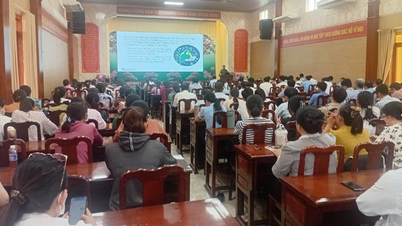Some local civil servants in China have begun being paid entirely in digital yuan.
Changshu, a city of 1.5 million people and a suburb of the Suzhou metropolitan area in Jiangsu, will switch to paying public sector employees in electronic yuan (e-CNY) from this month.
Before paying all public sector employees, the Changshu government conducted a trial of paying more than 4,900 employees of administrative agencies and state-owned enterprises in e-CNY from June to September last year. Changshu has 14,000 public sector employees, so paying all in e-CNY is expected to expand the currency to more people.
Previously, in March, Jiangsu Bank paid its employees in e-CNY. Last summer, Ningbo City (Zhejiang) paid 557 civil servants in the currency.

A point of acceptance of payment in electronic yuan in China. Photo: Reuters
According to Nikkei , some local governments have chosen to pay civil servants in e-CNY to create more widespread circulation incentives when this currency, after many years of testing, still faces fierce competition from mobile payment services for regular yuan.
Wages paid in e-CNY are deposited directly into digital wallets. Government agencies and banks only need to register the name and mobile phone number of the payee to process the payments. This approach reduces administrative costs compared to depositing money directly into a bank account.
e-CNY is managed by the People's Bank of China (PBOC). Research on it began in 2014. By 2020, Shenzhen had field tested it including ordinary citizens.
By March 2022, the trial had spread to 23 regions in 15 provinces and municipalities. In September, officials announced plans to conduct nationwide trials.
The e-CNY has yet to be officially launched, but the PBOC will benefit from its wider use. The central bank will be able to instantly identify data on payments, which will help it adjust monetary policy. The currency is also expected to curb illegal cross-border transfers and money laundering.
According to the PBOC, the test results have been achieved but only 13.61 billion e-CNY ($1.9 billion) will be in circulation by the end of 2022, accounting for 0.13% of the total yuan in circulation.
The lack of popularity stems from the belief that e-CNY is a copy of private-sector mobile payment platforms. WeChat Pay and Alipay are popular options in China, and many people cannot see the difference between those digital wallets and e-CNY.
Some pilots have offered vouchers for using e-CNY, but most will return to private e-wallets when the pilot ends. “We accepted e-CNY from 2021, but I hardly saw anyone using it,” said a worker at a restaurant in Beijing.
In January, Jiangsu finalized a policy to use e-CNY in public procurement, tax collection, and social insurance contributions. To promote consumption, a city in the province issued a total of 40 million e-CNY to residents for purchases.
The PBOC is looking to expand the infrastructure for the e-CNY. For one, payments in the currency could be made in areas with poor wireless connections by tapping phones together. Many smartphones will be compatible with that feature. The PBOC also aims to have wearable devices and smart cards compatible with the e-CNY.
Phien An ( according to Nikkei )
Source link































































































Comment (0)